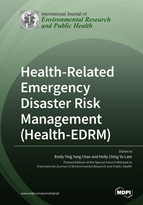Health-Related Emergency Disaster Risk Management (Health-EDRM)
A special issue of International Journal of Environmental Research and Public Health (ISSN 1660-4601). This special issue belongs to the section "Environmental Health".
Deadline for manuscript submissions: closed (28 February 2019) | Viewed by 112936
Special Issue Editors
Interests: health emergency and disaster risk management; climate change and health; humanitarian medicine; disaster public health; complex interventions; case studies
Special Issues, Collections and Topics in MDPI journals
Interests: environmental epidemiology; public health; climate change and health
Special Issues, Collections and Topics in MDPI journals
Special Issue Information
Dear Colleagues,
Disaster such as earthquakes, cyclones, floods, heat waves, nuclear accidents, and large scale pollution incidents take lives and incur very learge health problems. The majority of large-scale disasters affect the most vulnerable populations, which are often comprised of extreme ages, remote living areas, endemic poverty, as well as people with low literacy. Health-related emergency disaster risk management (Health-EDRM) [1] refers to the systematic analysis and management of health risks surrounding emergencies and disasters, and plays an important role in reducing the hazards and vulnerability along with extending preparedness, response, and recovery measures. This concept encompasses risk analyses and interventions, such as accessible early warning systems, timely deployment of relief workers, provision suitable drugs, and medical equipment to decrease the impact of disaster on people before, during, and after an event(s). Currently, there is a major gap in the scientific literature regarding Health-EDRM to facilitate major global policies and initiatives for disaster risk reduction globally.
This Special Issue of IJERPH invites papers describing/reporting the latest disaster risks and health risk analyses, as well as interventions for health-related disaster risk management. Disaster risk profiling and interventions can be at the personal/household, community, and system/political levels, and can be targeted at specific health risks including respiratory issues caused by indoor burning, re-emergence of infectious disease due to low vaccination coverage, and gastrointestinal problems resulting from unregulated waste management. Research outcomes and findings of multi-disciplinary studies are highly encouraged to submit to this Special Issue.
Reference
[1] Chan, E.Y.Y.; Murray, V. What are the health research needs for the Sendai Framework? The Lancet 2017, 390, e35–e36. doi:10.1016/S0140-6736(17)31670-7.
Prof. Emily Ying Yang Chan
Dr. Holly Ching Yu Lam
Guest Editors
Manuscript Submission Information
Manuscripts should be submitted online at www.mdpi.com by registering and logging in to this website. Once you are registered, click here to go to the submission form. Manuscripts can be submitted until the deadline. All submissions that pass pre-check are peer-reviewed. Accepted papers will be published continuously in the journal (as soon as accepted) and will be listed together on the special issue website. Research articles, review articles as well as short communications are invited. For planned papers, a title and short abstract (about 100 words) can be sent to the Editorial Office for announcement on this website.
Submitted manuscripts should not have been published previously, nor be under consideration for publication elsewhere (except conference proceedings papers). All manuscripts are thoroughly refereed through a single-blind peer-review process. A guide for authors and other relevant information for submission of manuscripts is available on the Instructions for Authors page. International Journal of Environmental Research and Public Health is an international peer-reviewed open access monthly journal published by MDPI.
Please visit the Instructions for Authors page before submitting a manuscript. The Article Processing Charge (APC) for publication in this open access journal is 2500 CHF (Swiss Francs). Submitted papers should be well formatted and use good English. Authors may use MDPI's English editing service prior to publication or during author revisions.
Keywords
- Health-related disaster risk management
- Natural disasters
- Intervention
- Community resilience
Related Special Issues
- 2nd Edition of Health Emergency and Disaster Risk Management (Health-EDRM) in International Journal of Environmental Research and Public Health (17 articles)
- 3rd Edition of Health Emergency and Disaster Risk Management (Health-EDRM) in International Journal of Environmental Research and Public Health (16 articles)
- Fourth Edition of Health Emergency and Disaster Risk Management (Health-EDRM) in International Journal of Environmental Research and Public Health (3 articles)






